The regenerative radio is long-ago superseded in commercial receivers, but it remains a common project for electronics or radio enthusiasts seeking to make a simple receiver. It’s most often seen for AM band receivers or perhaps shortwave ham band ones, but it’s a circuit which also works at much higher frequencies. [Perian Marcel] has done just this, with a regenerative receiver for the FM broadcast band.
The principle of a regenerative receiver is that it takes a tuned radio frequency receiver with a wide bandwidth and poor performance, and applies feedback to the point at which the circuit is almost but not quite oscillating. This has the effect of hugely increasing the “Q”, or quality factor of the receiver, giving it much more sensitivity and a narrow bandwidth. They’re tricky to tune but they can give reasonable performance, and they will happily slope-demodulate an FM transmission.
This one uses two tubes from consumer grade TV receivers, the “P” at the start of the part number being the giveaway for a 300mA series heater chain. The RF triode-pentode isn’t a radio part at all, instead it’s a mundane TV field oscillator part pushed into service at higher frequencies, while the other triode-pentode serves as an audio amplifier. The original circuit from which this one is adapted is available online, All in all it’s a neat project, and a reminder that exotic parts aren’t always necessary at higher frequencies. The video is below the break.
















It’s a superregen circuit but this article talks about regen :/ two different beasts
Both are mentioned here. It’s not a very creative link idea, ubviously.
https://en.wikipedia.org/wiki/Regenerative_circuit
The German names are different, by the way.
– Audion
– Rückkopplungsaudion (regenerative receiver)
– Pendler/Pendel-Audion/Pendelempfänger (superregenerative receiver)
Rückkopplungsaudion means back-feeding audion.
A part of the signal goes to input again, causing an oscillation.
This increases sensitivity level (the superregenerative receiver tops this even moreso).
It also can receive SSB and CW signals, akin to a normal receiver with an optional BFO (beat frequency oscillator).
If back-feed level is too high, this audion type can be used as a weak transmitter. For morse telegraphy, for example. Amateurs did that.
The Pendelempfänger translates to pendulum receiver.
It sweeps over the state of maximum and minimum of a signal, like a grandfather clock’s pendulum.
That results in a very high amplification factor and sensitivity. And a bit of self-noise.
It was used in 27 MHz CB Radio walkie-talkies in recent times.
The cheaper models used AM+FM modulation due to simplicity.
These names may sound odd in your foreign ears, but I think early radio history had two rivaling sides, essentially.
There was the English side with Marconi Corp. and the German side with Telefunken.
Speaking under correction.
Tubes aren’t exotic parts? Maybe when I was a little kid….
What, are you like 130 years old? :-D
“The RF triode-pentode isn’t a radio part at all, instead it’s a mundane TV field oscillator part pushed into service at higher frequencies”
Nothing is abused here. The RF triode/pentode PCF82 is a VHF mixer/oscillator that can do 300MHz and the PCL85 is a frame oscillator/output tube. Both of them are kept well within their specs.
Regenerative receivers are over 100 years old. They are , in my opinion, the most enjoyable radio to build and operate whether valve or solid state. Make sure you shield it well and anchor down anything that wiggles like wires. I enjoy seeing projects like this on HaD.
Yeah, me too. Such a simple but elegant circuit design, and one where workmanship and good parts make a difference. I have two tube regenerative receivers (one from a kit, one from scratch) that I still pull out and play with. (and a few solid-state scratch versions on perfboard that are still unhoused). This fall I brought the kit receiver out of storage to compare with a $80 portable multiband receiver I just bought, and on the same antenna, the old regenerative could pull in the same SW stations that the new radio could.
If I can lay my hands on the right tubes, I might give this FM superregen a go as well.
A few months ago, I was looking at my stash of old TV tubes, and thought “It’s a shame that most of these are specialized, and probably won’t see use, unlike more popular radio and guitar amp tubes!”
B^)
TEA5767 FM Radio Module ….. $0.99
And if you really want to be boring, most channels probably have a stream you can find on a website or in some app. This projekt is amazing. You have any idea of how complex FM receiving/decoding really is? This circuit is genious. Also, a very nice way to put some of those abundant “TV tubes” to good use – actually teaching you something.